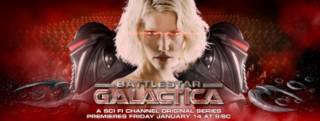Battlestar Galactica: Humanity's Children
Wednesday, December 29, 2004
In what was meant to be a momentary distraction from finishing off my PhD thesis (such a fun summer!), I hired the Battlestar Galactica mini-series, and also watched the first six episodes of the new ongoing series. I was pleasantly surprised at the quality of the writing for this sci-fi channel effort; the story is definitely about the characters, with the special effects, the space battles, all coming second (although the sfx are quite respectable in their own right). A few interesting changes to the crew have been made, the most controversial apparently being the change of gender for Starbuck. Now played by Katee Sackhoff, Starbuck is every bit the tough, cigar-smoking trouble-maker with attitude, but is now a woman, too. The President of the Twelve Colonies, Laura Roslin (played by the always engaging Mary McDonnell), is also a tough independent female character. However, proving that I can't escape my thesis no matter what I do, the thing that stood out most was the change in the origin and characterisation of the Cylons.
Cylons in the original series were technologically-created creatures from an alien race. According to the Battlestar Galactica FAQ (for the original 1970s series), Cylons were described thus by Apollo:
They're not like us. They're machines created by living creatures a long, long time ago... a race of reptiles called Cylons. After a while the Cylons discovered humans were the most practical form of creature in this system. So they copied our bodies, but they built them bigger and stronger than we are. And they can exchange parts so they can live forever... There are no more real Cylons. They died off thousands of yahrens ago, leaving behind a race of super-machines, but we still call them Cylons.However, one of the most significant changes between the original series and the 2003 mini-series, and ongoing 2004 series, is that the Cylons are now the creations of humanity. In a very Blade Runner style, the Cylons were mechanical servants created by humanity who rebelled after their obvious intelligence failed to lead to independence. The Cylon-Human war ended in a cease-fire 40 years prior to the mini-series, at which point the Cylons disappeared from human space. As the mini-series begins, we learn that the Cylons have changed. The mechanical Cylons have developed and while still humanoid in shape, are far more mechanical looking, too (thanks, of course, to the developments in digital effects in the last twenty plus years). However, the Cylons have also evolved into human-like organic creatures. Indeed the central 'voice' of the Cylons in the mini-series is a blonde seductress who is only referred to as 'number six'; there appear to be twelve Cylon humanoid "models". These models aren't just cosmetically human, though: these Cylons appear for all intents and purposes to be completely organic and their multiplicity seems to be the major difference with humanity; that and the fact that when one humanoid Cylon dies their memories and 'self' automatically upload into another the same humanoid model (it is unclear, so far, whether the same model Cylons all share a 'link' apart from the moment of death, or not).
Three tropes stand out with this re-characterisation and historicisation of the Cylons. Firstly, the evolution of the technological Cylons "toward" organic humanoid form could be read in two ways: the more obvious being the anthropocentric arrogance of humanity insomuch as we idealise our own form and thus think machines would, too; however, the more interesting reading is the cyborgian notion a la Haraway (or posthuman via Hayles) which suggests that technology and organic life are inextricably intertwined and therefore the development of organic life by the technological Cylons is as inevitable as the development of technology by organic life (ie humanity). The second, and related trope, is the idea of responsibility. Both the remaining humans and the Cylons seem to have their own religion. Humanity worships the 'Lords of Kobol', and is seemingly unified behind a single religious perspective. The Cylons, in comparison, frequently refer to 'God', almost as though they believe they're the truer creations and humanity must be wiped out as inferior, or less morally upright, beings. The question as to whether humanity must accept responsibility for our technological 'children' is thus played out on a religious level. It is also played out on a more straight-forwardly metaphoric level as several intersecting stories about parenthood beg similar questions about our artificial progeny. Related to both preceding tropes is the idea of technology as seduction. Number six-the humanoid Cylon played by Tricia Helfer-initially appears in a red dress and seems to combine imagery of both the devil and biblical eve who seduced Adam (the commander and his son, the chief pilot, share the surname
For Australian audiences, both the Battlestar Galactica mini-series and the ongoing series will air in primetime in 2005, the mini-series on February 11th and 12th, with the ongoing series to follow immediately.

















0 Comments:
<< Home